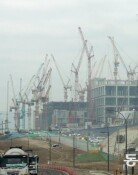What Road Will China Take in Pursuing Development?
What Road Will China Take in Pursuing Development?
Posted December. 18, 2008 07:26,
China today marks the 30th anniversary of its reform and opening up drive, but is facing a huge challenge in seeking quality national development.
The Chinese government has set a two-step modernization plan: feed its people and improve living standards to a more affluent level.
○ A decent life by 2020
The consensus is that the first step was achieved in 1990 and the first stage of the second step -- satisfying the peoples basic needs -- was completed in 2000, albeit a few differences according to region. China is expected to complete the second stage by 2020, when per capita income is expected to rise to 5,000 U.S. dollars.
Chinas modernization process will not end in the mid-21st century, however, because the living standards of the Chinese people will remain behind those in advanced countries. So Beijing says continuous efforts are needed.
○ Long road to political reform
Chinas push for reform and opening up began in the economic sector. The country has come a long way in economic development, but has seen little progress in political reform.
The late Chinese leader Deng Xiaoping stressed the importance of political reform as another pillar of Chinas modernization. The incumbent leadership, along with Chinese President Hu Jintao, also recognizes the necessity of political reform and democratization, but has failed to present concrete plans to achieve them.
Against this background, Chinese scholars are hotly debating the direction of political reform. Most of them support reform and further opening, but they split into three groups over what model China should follow.
One group led by former Renmin University Vice President Xie Tao wants a democratic socialist society, such as that of Sweden. The majority of scholars, however, advocate a Western European model where private property and market economic are accepted, but with group interests coming before private interests.
Other voices such as that of former Vice Premier Tian Jiyun prefer the U.S. model.
Regardless of what model they choose, all agree that change is needed in Chinas heavy-handed political system, in which the government controls everything and the Communist Party takes precedence over the nation. For change, scholars urge the government to be more transparent and the people to participate more in politics.
With today marking the 30th anniversary of China`s reform and opening up drive, the Chinese leadership has pledged uninterrupted reform and a further opening, but has not mentioned concrete measures. This implies that political reform will not come soon.
○ Social safety net needed
Along with political reform, social reform also constitutes an essential part of Chinas modernization. A major issue here is the establishment of a social safety net to provide assistance to the elderly, unemployed and those who are sick or suffering from injuries incurred from industrial disasters.
Those living in large cities are partially benefiting from a social safety net. Last year, the number of people with endowment insurance reached 201.4 million and that of people with health insurance was 223 million. These figures account for 70 percent of Chinas urban worker population of 293.5 million.
The situation in rural areas is largely different, however. Only seven percent of the rural population (51.7 million out of 727.5 million) benefit from endowment insurance and 4.3 percent (31.3 million) have health insurance. So the uninsured cannot afford to see doctors.
Narrowing the income gap is also an urgent task of the Chinese government. According to the Chinese magazine Caijing, the income of the wealthiest 10 percent of the population was 55 times that of the bottom 10 percent last year. Official government statistics, however, say the multiplier was 21.
The wealth gap between rural and urban areas is also widening. Last year, rural residents earned a net 4,140 yuan (605 U.S. dollars), or 30 percent of urban residents annual disposable income of 13,786 yuan (2,016 dollars).
Income also greatly differs by region. That of Gansu province was 6,835 yuan (1,000 dollars) last year, 10.5 percent of Shanghais 65,347 yuan (9,559 dollars).
○ Sound and fast development
China is the worlds second-largest exporter with volume reaching 1.2 trillion dollars last year. High-tech products, however, accounted for only 28.5 percent (347.9 billion dollars).
Last year, China consumed 16.8 percent of the worlds coal with 2.66 billion tons despite its gross domestic product accounting for a mere six percent of world GDP. This means Chinas energy consumption was three times the world average.
Since the Chinese leadership is well aware of this, it is emphasizing sound and fast development.
Economic growth of seven percent over the next 30 years will propel China to the ranks of advanced economies, but whether the country can achieve sound and fast development remains unclear.
The vice director of a Chinese think tank said, Celebrating the 30th anniversary of its reform and opening up drive, China is facing unprecedented challenges. The next five to 15 years will be a crucial period deciding Chinas future.
orionha@donga.com



![화장실 갇혔을 때 생존법…“최후에는 변기뚜껑” [알쓸톡]](https://dimg.donga.com/c/138/175/90/1/wps/NEWS/IMAGE/2025/12/26/133042007.3.png)



